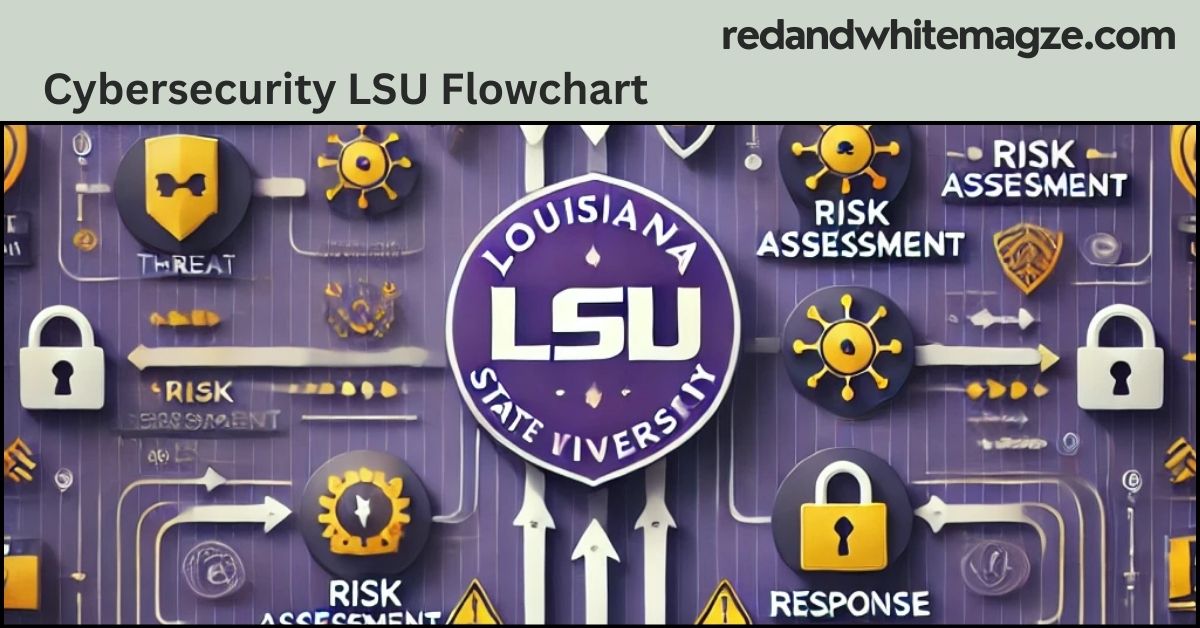Cybersecurity LSU Flowchart: A Comprehensive Guide
The Cybersecurity LSU Flowchart is a powerful tool designed by Louisiana State University (LSU) to help its community navigate the complexities of cybersecurity. It serves as a roadmap for identifying, analyzing, and mitigating cybersecurity risks. This flowchart benefits students, faculty, and staff by simplifying decision-making and ensuring a secure digital environment.
In today’s interconnected world, universities are prime targets for cybercriminals due to the sensitive data they manage, such as student records, financial information, and research data. The flowchart provides a step-by-step guide to addressing these risks effectively, ensuring the safety of LSU’s digital infrastructure.
Why the Cybersecurity LSU Flowchart Is Important
Cybersecurity threats have become more sophisticated over the years, targeting vulnerabilities in systems and networks. Educational institutions, like LSU, handle vast amounts of sensitive data, making them attractive targets for cyberattacks. The Cybersecurity LSU Flowchart is essential because it:
- Detects Threats Early: Early identification of potential threats reduces the likelihood of significant damage.
- Provides Structured Responses: It ensures a systematic approach to dealing with various levels of risk.
- Educates the Community: By offering clear guidelines, the flowchart helps users understand cybersecurity protocols.
- Prevents Data Breaches: Following the flowchart can significantly reduce the chances of data theft or loss.
For example, in the event of a phishing attempt, users can follow the flowchart to recognize the threat, assess its severity, and take appropriate action. This ensures that even non-technical individuals can contribute to a secure environment.

Key Components of the Cybersecurity LSU Flowchart
The Cybersecurity LSU Flowchart consists of several crucial components that guide users through identifying and addressing cybersecurity threats:
- Threat Identification
- This involves recognizing unusual activities, such as unexpected login attempts or phishing emails.
- Users are prompted to ask, “Is this activity typical for this system or user?”
- Risk Analysis
- This step categorizes the identified threat based on its potential impact.
- Questions include: “What data or systems could be affected?” and “How severe is the potential damage?”
- Response Strategy
- The flowchart offers predefined actions based on the risk level, ensuring an appropriate and timely response.
- For instance, low-risk issues may require basic troubleshooting, while high-risk threats demand immediate escalation.
- Post-Incident Review
- This involves evaluating the incident response to identify strengths and areas for improvement.
- The goal is to refine cybersecurity protocols and enhance future preparedness.
Step-by-Step Explanation of the Flowchart Process
Step 1: Identifying the Threat
The first step in the flowchart process is to identify a potential cybersecurity threat. This includes:
- Suspicious Emails: Emails requesting sensitive information, such as passwords or financial details, often signal phishing attempts.
- Unusual Login Attempts: Multiple failed login attempts or logins from unfamiliar locations may indicate unauthorized access.
- Malware Indicators: Slow system performance, unexpected pop-ups, or unauthorized software installations can suggest malware infections.
Users are encouraged to report any suspicious activity to the IT department for further investigation.
Also Read: Does Six Sigma Apply to SaaS? Unveiling the Potential
Step 2: Analyzing the Risk
After identifying a potential threat, the next step is to assess its risk level. The flowchart provides guidelines for evaluating:
- Severity: Determine how critical the affected system or data is to LSU’s operations.
- Scope: Assess the extent of the threat’s impact, such as whether it affects a single user or multiple systems.
For example, a phishing email targeting one student may be considered low-risk, while malware affecting multiple systems could be categorized as high-risk.
Step 3: Choosing a Response
Based on the risk analysis, the flowchart suggests an appropriate course of action:
- Low-Risk Threats: Actions may include running antivirus software or deleting suspicious files.
- Medium-Risk Threats: Users are instructed to contact the IT department for further investigation.
- High-Risk Threats: Immediate action, such as shutting down affected systems and notifying cybersecurity specialists, is required.
By following these recommendations, users can mitigate the threat effectively and prevent further damage.
Step 4: Documenting the Incident
Proper documentation is crucial for learning and improving cybersecurity measures. This step includes:
- Recording Details: Note the type of threat, how it was identified, and the steps taken to resolve it.
- Evaluating the Response: Assess whether the chosen response was effective and identify areas for improvement.
Documenting incidents helps LSU refine its cybersecurity protocols and prepares the institution for future threats.
Also Read: Purdue Lean Six Sigma Green Belt Case Study Notes: A Comprehensive Guide to Mastering the Process
How LSU Implements the Flowchart
1. Training Sessions
LSU organizes regular workshops and training sessions to educate students, faculty, and staff on using the flowchart. These sessions include:
- Interactive Exercises: Participants practice identifying and responding to simulated cybersecurity threats.
- Case Studies: Real-life examples of cybersecurity incidents at LSU are analyzed to highlight the flowchart’s effectiveness.
2. Digital Accessibility
The flowchart is readily available on LSU’s cybersecurity portal, ensuring easy access during emergencies. It is also downloadable in various formats, such as PDFs and mobile-friendly versions.
3. Continuous Updates
Cybersecurity threats evolve rapidly, and LSU’s IT department regularly updates the flowchart to address emerging risks. Users are notified of updates through email and the cybersecurity portal.
Benefits of Using the Cybersecurity LSU Flowchart
- Enhanced Awareness
- Users develop a deeper understanding of potential cybersecurity threats and how to recognize them.
- Quick Decision-Making
- The structured process reduces hesitation and confusion during critical situations.
- Improved Institutional Security
- A unified approach to cybersecurity ensures that LSU’s digital infrastructure remains secure.
- Reduced Downtime
- Swift responses minimize disruptions to academic and administrative activities.
Common Cybersecurity Threats at LSU
Phishing Attacks
Phishing involves deceptive emails or messages that trick users into revealing personal information, such as passwords or credit card numbers. These attacks often appear to come from trusted sources.
Malware
Malicious software, such as viruses, worms, and spyware, can infect systems and compromise data. Malware often spreads through infected email attachments or malicious websites.
Ransomware
Ransomware encrypts files and demands payment for their release. These attacks can paralyze entire systems and cause significant financial losses.
Also
Social Engineering
Social engineering manipulates individuals into divulging confidential information or performing actions that compromise security. Examples include impersonation and pretexting.
Tips for Maximizing the Flowchart’s Effectiveness
- Stay Updated
- Regularly review LSU’s cybersecurity policies and updates to the flowchart.
- Practice Scenario Simulations
- Engage in practice drills to ensure familiarity with the flowchart.
- Report Suspicious Activities Immediately
- Prompt reporting ensures swift action and minimizes risks.
- Use Strong Passwords
- Secure your accounts with complex passwords and change them regularly.
- Enable Two-Factor Authentication (2FA)
- Adding an extra layer of security can prevent unauthorized access.
Frequently Asked Questions (FAQs)
What is the purpose of the Cybersecurity LSU Flowchart?
The flowchart guides LSU students, staff, and faculty through identifying and responding to cybersecurity threats.
How often is the flowchart updated?
It is updated regularly to address emerging threats and incorporate best practices.
Can non-technical users understand the flowchart?
Yes, the flowchart is designed for users with varying technical expertise and includes clear, simple instructions.
What should I do if I suspect a cybersecurity threat?
Refer to the flowchart for guidance, assess the risk level, and follow the recommended actions, such as reporting to the IT department.
Where can I access the Cybersecurity LSU Flowchart?
It is available on LSU’s official cybersecurity portal and can be downloaded for offline use.
What types of threats does the flowchart address?
The flowchart covers a wide range of threats, including phishing, malware, ransomware, and social engineering.
How can I improve my cybersecurity skills?
Participate in LSU’s training sessions, review cybersecurity resources, and practice using the flowchart in simulated scenarios.
Conclusion
The Cybersecurity LSU Flowchart is an invaluable resource for the LSU community, offering a clear and structured approach to tackling cybersecurity threats. By understanding and utilizing this tool, users can enhance their cybersecurity awareness and contribute to a safer digital environment at LSU. Familiarizing yourself with the flowchart is a critical step in staying ahead of potential risks and ensuring the integrity of LSU’s digital infrastructure. Whether you’re a student, faculty member, or staff, this flowchart empowers you to play an active role in protecting LSU’s digital assets.






